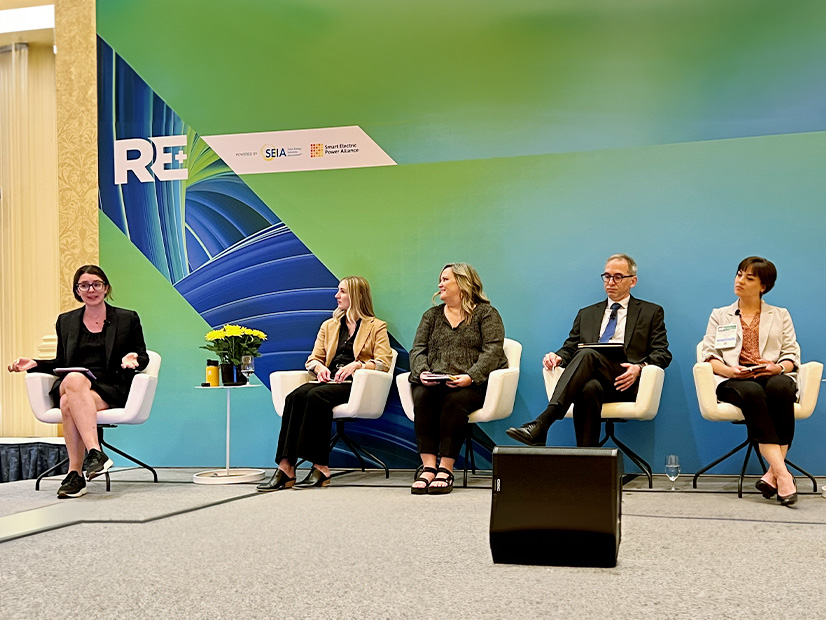
LAS VEGAS — Utilities and customers both benefit when proactive hosting capacity planning is used to get ahead of the rising demand for distributed energy resources, said panelists at the RE+ conference, held last week at the Venetian Expo and Caesars Forum.
Looking ahead at the potential for distribution circuits to handle high penetrations of DERs not only prevents unfair allocation of upgrade costs but also enables utilities to prioritize upgrades where they are needed most.
Transparency is an essential part of proactive hosting capacity planning, said Erin Ankeney, director of interconnection at residential solar installer Freedom Forever.
“Utilities should be mandated to have their information public about hosting capacities and their availability on the grid. It shouldn’t take a customer and the contractor to get through the whole contract to find out that the system size that was submitted or proposed is not eligible to be installed in that area without a costly upgrade,” she said.
Utilities need to end today’s practice of reviewing one interconnection application at a time and expecting the customer that triggers the need for a distribution grid upgrade to pay the full costs, said Radina Valova, regulatory vice president at the Interstate Renewable Energy Council.
With proactive hosting capacity planning, the utility “would begin by estimating the hosting capacity of distribution circuits in advance of setting any particular project, then analyze the circuit’s ability to accommodate the anticipated DER growth and would determine where any potential infrastructure upgrades have to happen,” Valova said. “The utility would proactively undertake those upgrades and then apply optimal recovery.”
Ankeney said antiquated rules and procedures are “not keeping up with the growth of the DERs and the scale of complexity that we’re seeing in today’s market.” She said challenges ranged from administrative pain points, to engineering screens, to grid transparency.
The result is a slow and frustrating process, Ankeney said. “We’re seeing anywhere from 20 to 30 business days just to get [a residential system] approved to install, whereas on the commercial side, we’re talking hundreds of days or years.” After the project is built, “we have to also go through those same timelines to get jobs interconnected and fully operational with permission to operate,” she said.
Utilities’ application systems are also antiquated, and delays can stem from something as petty as mis-entering a customer’s address, a problem easily eliminated by the kind of simple address validation used on every ecommerce site.
Interconnecting the DER Dots
Some states — but not enough — are already beginning to explore proactive hosting capacity planning, said Samantha Weaver, director of interconnection and grid integration policy at the Coalition for Community Solar Access. While 21 have an active proceeding on distribution system planning requirements, “only a handful of those states are looking at distribution system planning in the proactive hosting capacity planning concept. This is not a widely practiced concept yet.”
Weaver said New Jersey, Maryland and Massachusetts are engaged in the preliminary discussions. “What they all have in common is that they are all seeking to develop a framework for utilities to recover investments in distribution infrastructure in advance of projects seeking to interconnect.
“For example, both Maryland and New Jersey have proposals in the early stages that would require utilities to forecast congested areas on the distribution system and propose system upgrades accordingly. Then you get into questions around how much those upgrades cost and who pays for them. The way that Maryland and New Jersey are looking at this is they’re proposing a $1/kW hosting capacity upgrade fee. Each interconnecting customer who comes along will have to pay to interconnect under this framework.”
Weaver said both states’ proposals fail to solve one key problem related to cost allocation: “Eventually these upgrades reach a point where they become too expensive for a single project or even a group of projects to support. So even if these high costs to upgrade a substation are shared among all future interconnecting customers, they’re still too high, and nobody’s going to build a project there.”
Studies in Maryland have shown realistic hosting capacity fees would be $500 to $1,000/kW, Weaver said. “Those are project-killing costs.”
DERs with Ph.D.s: An Explainer
The grid is an ecosystem, not a science experiment: It’s impossible to hold everything constant while changing only one variable.
This means that utilities cannot assume everything else stays constant on a distribution circuit as one variable — the number of buildings with rooftop solar, for example — changes. The evolving nature of DERs means that there are many changes happening simultaneously: rooftop solar adding to the grid in the day; batteries sopping up the excess and storing it for when it’s needed; and electric vehicles plugging in and not only charging during the night, but possibly feeding into the house during peak demand.
The intersection of big data and small energy has resulted in sophistication well beyond reacting to simple demand response requests. A home battery management system, for example, may layer customer-defined parameters (always having at least 30% charge at the end of an evening) with forecast inputs (tomorrow will be sunny), predicted demands (weekend road trips mean the EV will drink a lot of electrons Saturday night) and scenario planning (hot dry summer means more likelihood of a planned blackout to lower fire risk).
Add to that the increasing sophistication of the many players in a home’s DERs, such as a bidirectional charger that can tap into an EV’s many Powerwalls worth of energy storage, or a hybrid hot water tank that can act as a thermal battery, and capacity planning isn’t simply additive. Modeling capacity today needs to account for the potential of some DERs to help smooth out or even negate the rising demand coming from electrifying homes and transportation.